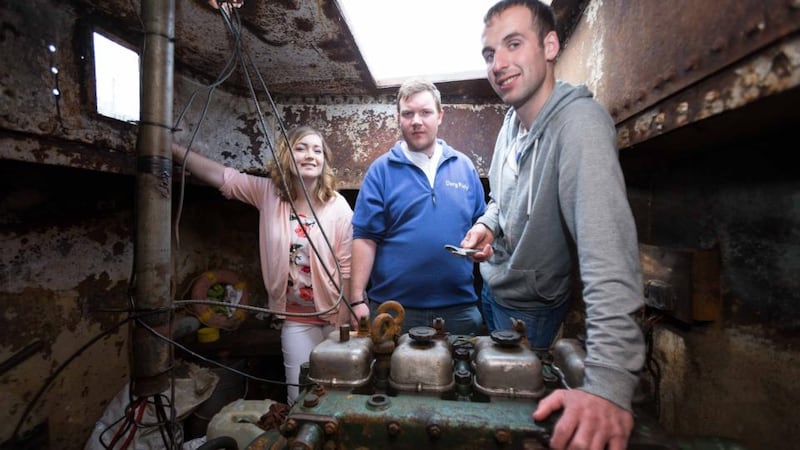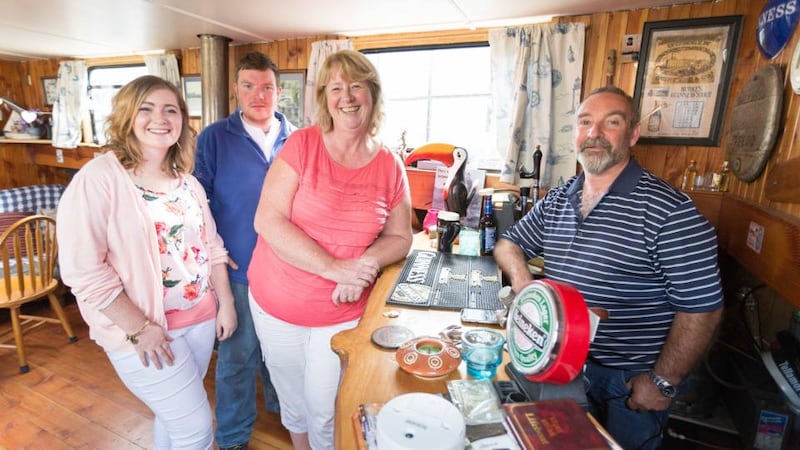Aoife Burke sat on her new canal boat as it emerged gradually from the murky Royal Canal. “Buying boats underwater . . . it didn’t even seem like an issue because of the way I grew up and was raised,” she says, recalling the day her chance to own one literally surfaced. “I was on a barge like this [when I was] in nappies.”
Well, not quite like this. Burke, a 22-year-old art student and heritage boat enthusiast, is one of seven people, five in their teens or early 20s, who tendered for and bought seven sunken canal boats from the bowels of Ireland’s waterways.
What emerged was subject to some degree of luck but these are the last of a traditional craft reborn from the interior, and it was worth any risk.


Eighteen months later, Burke is standing on a small dock at Portumna in Galway, looking over her barge – a hollow, dark brown, steel hull partially filled with water – pointing to where she will eventually build her four bedrooms and artist’s studio.
Her eyes illuminate at the prospect. “It’s a whole life. It’s the way our minds work; the way we have grown up,” she says.
Heritage
“It’s the last lot that the Government are selling off. It was my last chance, the only chance I would probably get in my life.”
There are about 40 retired canal boats like this in the country. In 2013 Waterways Ireland decided to auction the last remaining seven, five of which had been raised from the bottom of Tullamore Harbour.
The Heritage Boat Association (HBA), which has about 80 members and families, lobbied the State body to consider the boats' cultural and historic value when finding buyers. To the considerable gratitude of the association, it did.
“A leap of faith,” explains Paul Martin, former chairman of the sales. “You had to buy them under the water and tender for them and you had to give Waterways Ireland an undertaking that you had the capabilities and expertise to raise them and get them out of Tullamore Harbour. And what your ongoing plans were for the boat. These are heritage boats . . . so they wouldn’t be lost.”
The barges, correctly called canal boats, fell out of favour in the 1950s when road and rail decimated the traditional transport network. Mostly run by the Grand Canal Company, they had been known as “Guinness barges” because stout was often their cargo.
According to records of June 1951, Aoife's boat, the 33M (the M being for motor), carried just over five tons (4.5 tonnes)of tobacco, glass and wheat to Limerick; 13 tons of manure to Kilgarvin and a row boat to Dromineer.
Many of the boats were eventually sunk, or allowed to sink, to preserve them and as a means of clearing the waterways. Piece by piece, Ireland’s canal history was cast to the depths, or sold for scrap.
“It was fresh water as distinct from still water,” explains Paul. “A mix of salt and air is what corrodes a boat so they were sunk to preserve them, not to get rid of them. They came up in remarkably good condition.”
Before the sale, the boats were briefly raised to allow perspective buyers a glimpse, before letting them sink again.
“We felt it was important that another generation got involved with the heritage of the boats and so we approached young members [to buy them].”
Each, with varying degrees of wear, has an engine room to the stern and a cabin at the bow. “Other than that they were like a wheelbarrow.”
Vision
Weighing between 15 and 20 tons, they are mainly made of steel but sometimes iron. Some of the engines, fitted in the 1940s, still worked.
The purchase prices were kept secret but various estimates put the cost at between €15,000 and €20,000 each. Renovators can spend any amount but materials cost at least €30,000 to €40,000.
“None of these guys are driving new cars,” says Gerry Burke, father of Aoife, and Daniel (24) who also bought a boat.
“You have to have a vision to see what a boat is like beyond its superficial state. To me it’s like buying a site: you have the ground but you have to see the house.”
He speaks with some authority: Gerry and his wife Geraldine bought their barge in 1995 and slowly set about renovating the bare-steel hull into a four-bedroom houseboat the size of two mobile homes.
On board the barge, docked at nearby Terryglass, there are pictures of renovations spread over years with Aoife, true to her word, and Daniel as children.
In the wheelhouse rubber ducks line the windowsills; the navigation chair is an old pilot’s seat from a stripped down 737 (Gerry works in airline salvage).
A sign on the wall declares: “Pirates only. All others walk the plank.”
Aside from its numerous quirks (there is a working bar carved to resemble the side of a boat), the Burke family barge is a masterclass in what you can do with an enormous hollowed-out piece of floating steel. Even if it takes a life of loving dedication.
Daniel’s boat is moored nearby. Unlike the five raised from Tullamore, his surfaced from the River Barrow and sat forlorn in a car park for five years. There is a picture of the scene hanging on its Portakabin wall beside some of Daniel’s belongings.
Enthusiastic
“I just started painting it straight away. I wanted to start using it,” he says.
Like Aoife and his father, Daniel enthusiastically talks about his plans. The Burke’s love affair with canal boats is matched by a determination to maintain them. It is a generational pursuit.
“I was always saving to buy a boat and when this tender came up it was a sister ship to my father’s boat,” says Daniel.
“I know how it works; it was a no-brainer.”














